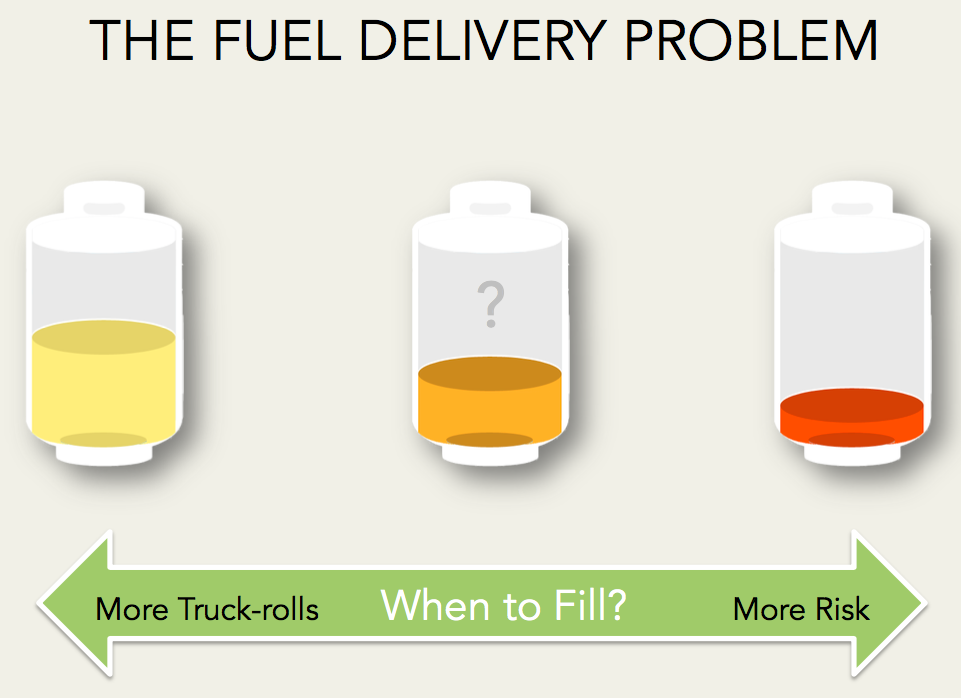Competition for propane customers is fierce, however, it’s not just the product that customers buy but the relationship. It’s no secret that customer stickiness is measured on this relationship and it hinges on transparency and delivery on the promise of “we will keep you full!” Fail that and you’ll experience churn. Succeed and you’ll see your revenue grow.
But our sole focus can’t just be ensuring tanks are full. Consistent revenue is great but every truck roll means less profit with considerable costs in fuel, equipment, trucks and man power. How you balance customer service with delivery efficiency determines if your business is profitable and how profitable it can be.
The other aspect of propane tank monitoring that can impact profitability is the types of customers you put tank monitors on. The alternative to tank monitoring is a formula using degree days and K-factors and there are accounts where the formula works pretty well.
This blog post is about the customer accounts where tank monitoring is the best and most profitable option.
6 Customer Account Types That You Should Be Monitoring
While the above are general rules to customer accounts where tank monitoring provides value, we see the following types of customer accounts as key prospects where tank monitoring can greatly improve your relationships and profitability through delivery efficiency.
Here are six accounts that you should seriously consider monitoring:
This is the prime example of unpredictable usage and is nearly impossible for a propane marketer to predict. Peak consumption occurs around weekends, holidays, or guest visits and is very weather dependent. Worst of all, if a customer runs-out it means a ruined pool party, cook-out or gathering, which you never want them associating with your brand.
Consumption on a propane greenhouse heater is also nearly impossible to forecast. Usage depends on the type of products grown in the greenhouse and the harvest schedule for those products – sometimes the greenhouse is full and other times it is empty but the marketer is often the last to know.
A run-out could mean your customer loses potential business and product which cuts into their revenue and profit. Bad news!
The poster child of the worst possible run-out. Outside of the often unreliable local outage report from utilities, it’s difficult for propane marketers to know when their customers experience a power outage and when a generator goes into effect. Propane generator tanks contain only a week’s quantity of fuel, so calling or going door-to-door to identify customers in need is likely the only way to understand how much fuel was used. That means sending trucks to every generator customer to top off after every storm which is inefficient or gambling that each generator has enough to weather the next storm. A huge risk with the potential of a customer being without heat when the power goes out.
When propane is used solely to heat a primary residence degree days and k-factors can be a fairly accurate way to estimate usage. However, when a house is a second home most owners will turn the heat down drastically when they are not occupying the house. This causes long and random periods of low-usage, punctuated by heavy consumption – often on weekends and holidays. Your degree day calculations will become very inaccurate causing both small drops and run-out emergencies. Making matters worse, these second home owners often have additional difficult to forecast luxuries like generators, pools, and gas logs!
Propane for cook-outs is in high demand in the summer and refill stations are a critical revenue source for commercial customers. A propane refill station displays variable, high, and critical consumption characteristics that make these tanks perfect candidates for a tank monitor. These locations can swing wildly as demand varies from BBQ cylinders, RV tanks, forklifts, food trucks and more. Often this means a truck is delivering multiple times a day to ensure that their customers have the propane needed to satisfy summer demand.
A propane restaurant customer is tough to forecast because of their multiple uses all pulling off of a single tank: space heat, cooking, hot-water, and often a generator. Of course cooking itself comes in various forms with a bakery’s propane oven burning gas at a different rate than a burger shack’s propane cook stove. Seasonal demand also comes into play catering towards summer or winter activities and food preferences.
Ensuring Propane Reliability Without Wasting Resources
Tank Monitoring is all about the give and take around avoiding run-outs while ensuring delivery schedules that limit the costs associated with serving your customers. When deciding to invest in tank monitoring, make sure to identifying and rank order the accounts that fit the criteria above and analyze the deliveries you make to these accounts. This will set the foundation to ensure your investment yields a return in savings that can be spent elsewhere in the business.
Good luck!
If you are interested in more examples of these 6 customer accounts and the value of tank monitoring, download our “6 Customers That Need Tank Monitoring” Guide!
 Shop
Shop